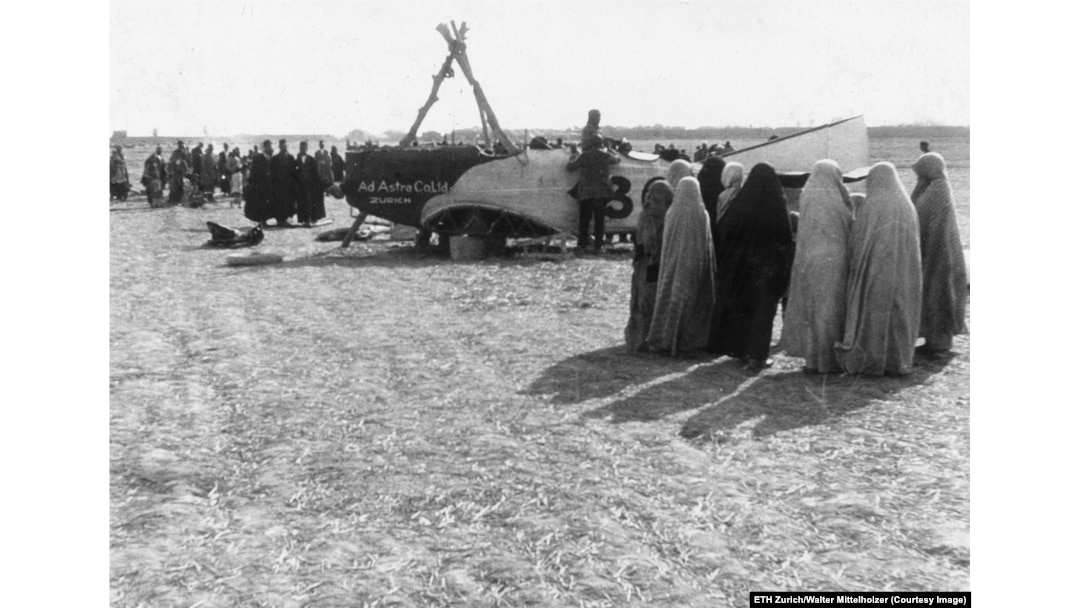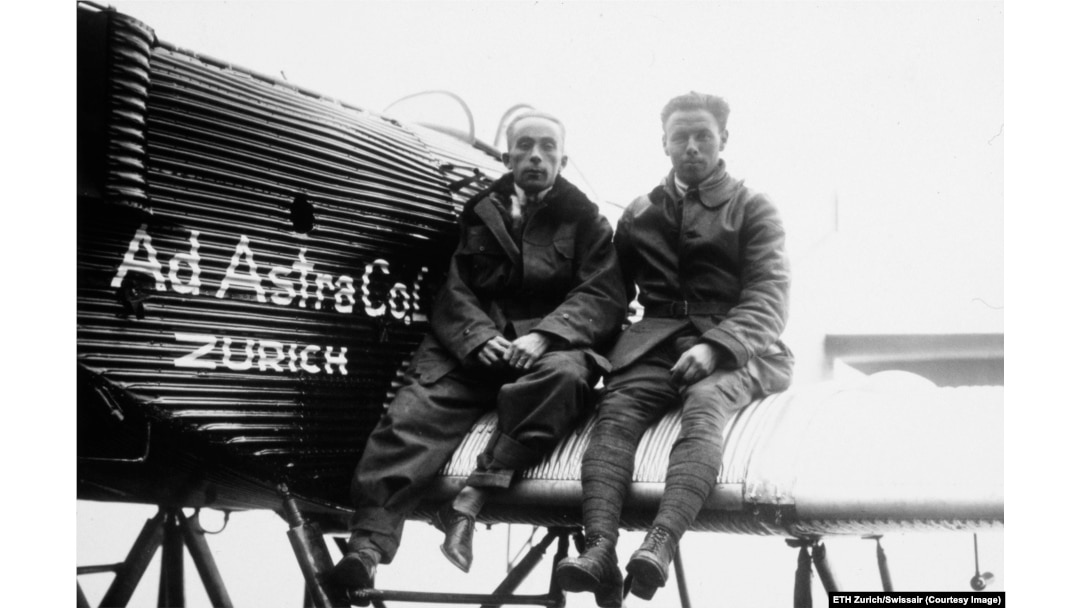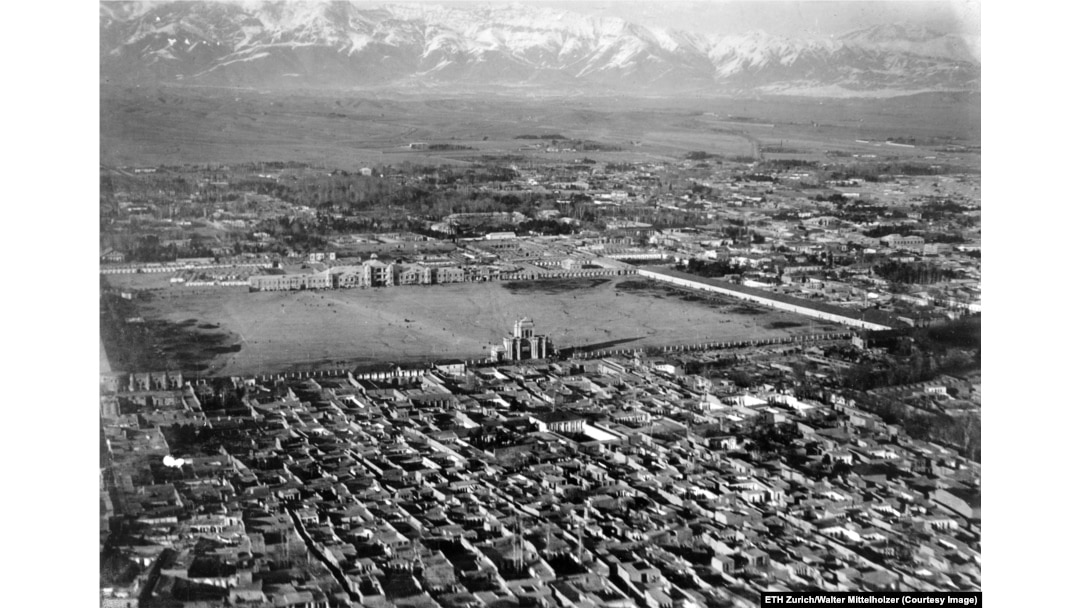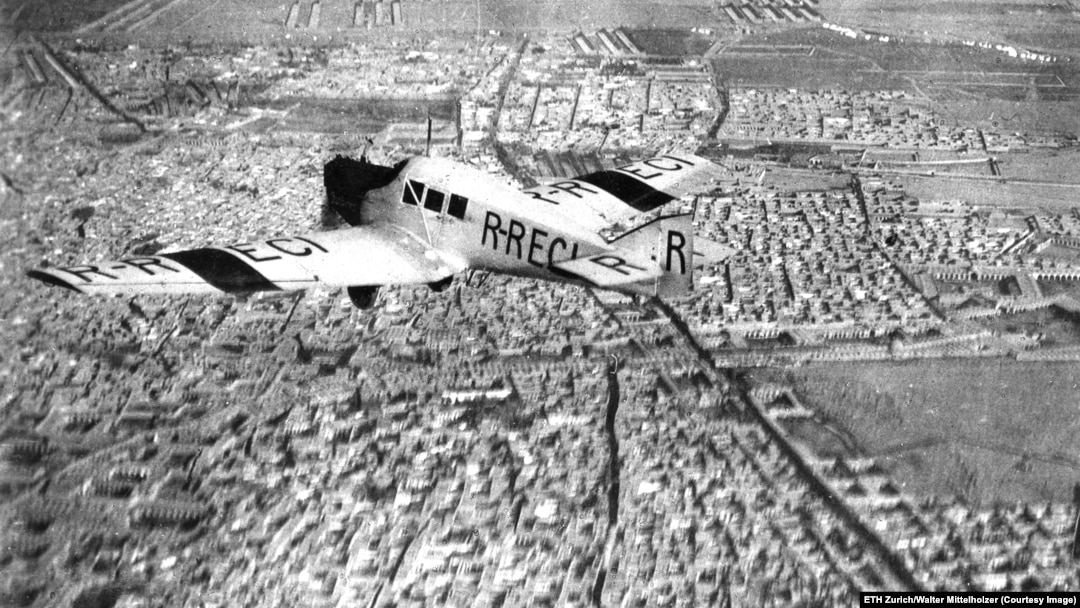In the winter of 1924, inhabitants of a small village near Tehran looked up as a metal-bodied airplane swooped in to land, bumped along a field, then collapsed in a cloud of dust after its landing gear broke.

Women in burqas watch as Walter Mittelholzer’s plane is repaired outside a settlement 40 kilometers from Tehran in December 1924.
The pilot of the plane was Swiss aviator Walter Mittelholzer, who had received an invitation from the Persian government to deliver a new Junkers aircraft to the country, which would be renamed Iran in 1935.

Swiss aviator and photographer Walter Mittelholzer (left) and mechanic Ernst Bissegger before their 1924 flight to Persia
Kaspar Surber, a Swiss journalist who wrote a book on Mittelholzer, told RFE/RL the aviator was chosen for the flight to Persia in part to "popularize flying" through aerial images he would take there.
Mittelholzer was famous at the time for becoming the first person to extensively photograph Switzerland's mountains from an airplane.

Tehran photographed from an altitude of 400 meters with the Alborz mountain range in the background
In the 1920s, Surber says there was something of a "race" between German and British aviation companies to begin air services in Persia, making Mittelholzer's photography skills a key promotional advantage.
A Swiss newspaper wrote of the aviator, "The Swiss people know what to expect from their Mr. Mittelholzer, who can not only pilot a plane across unknown countries but also photograph and film in flight."
The Shah Abdol-Azim Shrine in northern Iran
After their ignominious landing 40 kilometers outside of Tehran, Mittelholzer and mechanic Ernst Bissegger had a tense confrontation with villagers before help eventually arrived from the Persian capital and their aircraft was repaired.
Locals pull Mittelholzer’s plane into position at an airfield in Persia.
Mittelholzer and Bissegger's flight of more than 3,000 kilometers from Switzerland to Persia included a standoff with Turkish authorities who confiscated their plane, troubles with poor-quality gasoline purchased in Baghdad, and erroneous maps that forced them into the ill-fated landing during which their plane's landing gear collapsed.
A river cuts through an unidentified Persian mountain range.
Mittelholzer’s initial impressions of the territory of Persia from above were of "areas that lie desolate and empty and wander past the observing eye for hours. Huge alluvial fans, piles of rubble, and deltas of saline rivers [that] characterize the country."
A small village in Persia
Isolated settlements occasionally came into view as the pair flew over Persian territory.
"Here and there a green patch shines," Mittelholzer wrote, "a space in the center of which features residents' mud huts rising on narrow and winding streets. Silver bands mark the irrigation channels at the edges of the gardens."
Bushehr, a town on the Persian Gulf, is seen from an altitude of 300 meters.
Mittelholzer seized the opportunity to photograph Persia extensively from above in photographs that are now held by the ETH Zurich library.
The port in Bushehr
The Swiss aviator and photographer also made use of his camera on the ground to capture a country on the cusp of dramatic change under Reza Shah Pahlavi, a ruler who would become known as Persia's "modernizing strongman."
A walled village in Persia photographed from Mittelholzer’s plane
At the time of Mittelholzer's visit to Persia, the country was without major rail or road networks, and camel caravans were still in use as a means of foreign trade, making air transport an enticing possibility for the country's rulers.
Isfahan, in the center of today's Iran, as seen in 1924
With the aviation industry still in its infancy in Persia, Mittelholzer and Bissegger had the sky virtually to themselves as they swept low over urban centers to snap images that would soon stun European audiences.
A Junkers airplane photographed by Mittelholzer flying over Tehran
Mittelholzer predicted that aerial photography would play a significant role in documentary imagery of the future.
"Another hitherto unseen world opens up before us. It is as if the Earth has thereby gained a new face, and man a new, unflawed eye," he wrote in 1928.
A fishing vessel under construction in Bushehr
After spending several weeks inside Iran, the two Swiss aviators eventually made the long trek back to Central Europe by car. Mittelholzer would later co-found a company that became Swissair, Switzerland's national carrier until 2002. He died in a mountaineering accident in 1937 aged 43.
Kashan, in today’s Isfahan Province of Iran
In a newspaper obituary, a friend noted that Mittelholzer's death in the mountains that he loved, and that had sparked his extraordinary career, had a certain tragic poetry: "They have embraced him 0n his last wanderings and claimed him, and perhaps he would not have wished for a better end, but alas it came all too soon, there was so much more for him to do."


